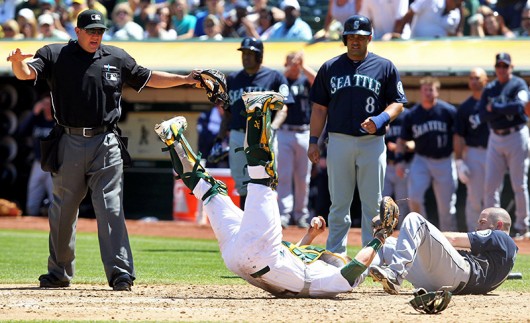
Seattle Mariners outfielder Dustin Ackley (right) is called safe at home after a collision with Oakland Athletics catcher Stephen Vogt (middle) Aug. 21 at O.co Coliseum. Seattle won, 5-3.
Courtesy of MCT
A new rule adopted by Major League Baseball Monday is set to alter one of the only contact plays in baseball — the home plate collision.
The adjustment of this old-school play will surely lead to a great deal of objection from fans and former players from a more gritty era, but it has to be considered the appropriate move from MLB commissioner Bud Selig and the MLB Players Association.
The experimental rule states that a runner who uses his shoulders, hands, elbows or arms to push through the catcher without any effort to touch the plate will be automatically ruled out, even if the catcher drops the ball. On the flip side, if the catcher attempts to block the plate without possession of the ball, the runner will be called safe even if he doesn’t touch home.
A collision at the plate is as exciting as anything in a sport that many people have classified as “boring.” However, it doesn’t seem to have any place left in a time when the safety of players — especially when it comes to head injuries and concussions — is the No. 1 priority.
In a sport where players usually don’t have to worry about being targeted physically by a member of the opposition, catchers — who already the most physically demanding position — are put at an unfair risk.
Off the top of my head, I can think of several gruesome injuries to a catcher from a home plate collision.
Former Miami Marlins center fielder Scott Cousins broke San Francisco Giants catcher Buster Posey’s leg in 2011, and former Los Angeles Angels catcher Bobby Wilson sustained a concussion and left ankle sprain in 2010 from a collision with New York Yankees first baseman Mark Teixeira.
Arguably the most infamous collision came in 1970 when the Indians’ Ray Fosse’s career was derailed by a separated shoulder from a violent collision courtesy of former-Cincinnati Reds third baseman Pete Rose — in the All-Star Game, no less.
The justification for physical contact with the catcher has always been the fact that catchers wear protective gear not found on position players, but it is clear this is not enough.
The flaw with the new rule is it says a catcher would be allowed to block the plate if the umpire determines he needed to do that in order to field the ball and contact could not be avoided. This turns the ruling into an umpire’s judgment call, which will inevitably lead to a controversial situation somewhere down the line.
The MLB said video replay would be allowed to determine the correct call in a situation like that, but that could just lead to more confusion and outrage.
Still, this rule was a long time coming and had to be done. Of course, as a baseball fan, I will miss the heart-pounding action of a base runner barreling into a catcher who is squeezing the ball with all of his might.
But I would rather miss out on that action than see another catcher’s season end because of a violent play, because that is not what baseball, or any sport, is about.


